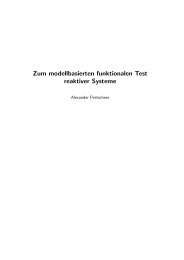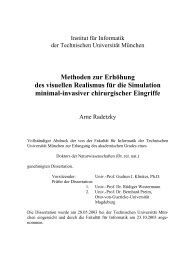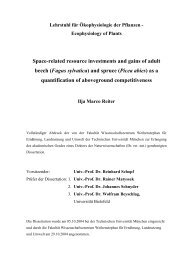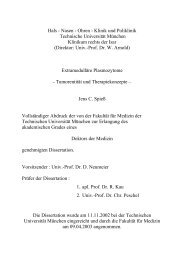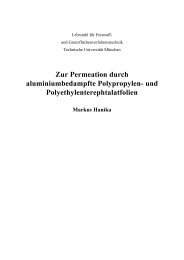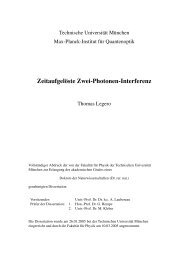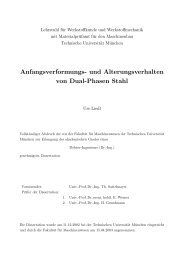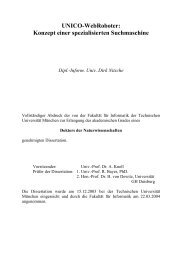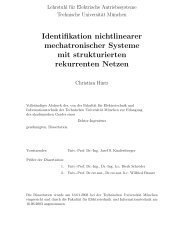Controlling the motion of an atom in an optical cavity
Controlling the motion of an atom in an optical cavity
Controlling the motion of an atom in an optical cavity
Create successful ePaper yourself
Turn your PDF publications into a flip-book with our unique Google optimized e-Paper software.
10 2.2. Classical calculation<br />
Phase shift per round trip<br />
Cavity<br />
Atom<br />
Total<br />
Tr<strong>an</strong>smission<br />
a<br />
Frequency<br />
c<br />
Frequency<br />
Phase shift per round trip<br />
Cavity<br />
Atom<br />
Total<br />
Tr<strong>an</strong>smission<br />
b<br />
Frequency<br />
d<br />
Frequency<br />
Figure 2.3: a), b) Phase shift per round trip <strong>of</strong> a light field <strong>in</strong> <strong>an</strong> empty <strong>cavity</strong>, phase<br />
shift <strong>in</strong>duced by <strong>an</strong> <strong>atom</strong>, <strong>an</strong>d result<strong>in</strong>g phase shift for <strong>the</strong> <strong>cavity</strong> with <strong>an</strong> <strong>atom</strong> <strong>in</strong>side<br />
as a function <strong>of</strong> <strong>the</strong> light frequency. c), d) The tr<strong>an</strong>smission <strong>of</strong> <strong>the</strong> <strong>cavity</strong> with <strong>an</strong><br />
<strong>atom</strong> drawn aga<strong>in</strong>st <strong>the</strong> light frequency. In a) <strong>an</strong>d c), <strong>the</strong> reson<strong>an</strong>ce frequencies <strong>of</strong><br />
<strong>atom</strong> <strong>an</strong>d <strong>cavity</strong> are <strong>the</strong> same, whereas <strong>in</strong> b) <strong>an</strong>d d), <strong>the</strong> reson<strong>an</strong>ce frequency <strong>of</strong> <strong>the</strong><br />
<strong>atom</strong> is larger th<strong>an</strong> that <strong>of</strong> <strong>the</strong> <strong>cavity</strong>. The peaks <strong>of</strong> <strong>the</strong> tr<strong>an</strong>smission are near to<br />
laser detun<strong>in</strong>gs where <strong>the</strong> total phase shift per round trip is zero, as <strong>in</strong>dicated by<br />
<strong>the</strong> dotted black l<strong>in</strong>es.<br />
here.<br />
2.2 Classical calculation<br />
In this section, a Fabry-Perot type <strong>cavity</strong> is considered. It consists <strong>of</strong> two identical<br />
mirrors which are separated by a dist<strong>an</strong>ce l, see Fig. 2.1. The mirrors have a power<br />
reflect<strong>an</strong>ce R, a tr<strong>an</strong>smitt<strong>an</strong>ce T , <strong>an</strong>d losses L, withR + T + L = 1. It is assumed that<br />
<strong>the</strong> mirror reflect<strong>an</strong>ce is close to one, <strong>an</strong>d <strong>the</strong> <strong>cavity</strong> geometry is such that it susta<strong>in</strong>s<br />
a stable mode (Sie86, chapter 19, Eq. (8)). On one side, <strong>the</strong> <strong>cavity</strong> is illum<strong>in</strong>ated with<br />
monochromatic light characterized by <strong>the</strong> electric field amplitude E<strong>in</strong> <strong>an</strong>d wavelength λ,<br />
10



